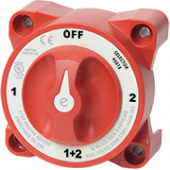I run 174AH & 280AH in a split bank.. Split meaning that 174's are on one (1) side of a

switch & 280's on another (2). This is a 105AH difference and IMO the practical limit for difference because when Charging the 174's EndAmps (8.7A) is reached and allows the 280's to continue to saturate a bit deeper to 3.425Vpc. The time that this takes is minimal and while the 174's are FULL @ 4.425, they sit idle taking no charge, the 280's continue to take the extra till 100% and then goto idle as well. At this point they may exchange a few volts between packs as settling is ongoing. (Normal & Expected)
On Discharge, there is NOTHING Different while within the Working Voltage Range of 3.000-3.400, all packs discharge "Proportianiately" according to their capacity. Simplistic #s, Say load is 24A draw, the 2x 280's will deliver 10A ea while the 2x174's will deliver 7A each. Again this is normal & appropriate.
Once you drop BELOW Working Voltage Range that's where things get fun. The packs will try t stay propertional BUT once they cross 2.850 and lower then you will get the divergence when the 280's over compensate and voltgaes drop fast after 2.850, Remember this is the Bottom Cliff Fall of the "Allowable Voltage Range".
Having 200AH next to 300AH should not present major issues till at edges. BUT that is the limit because if it was 200AH & 400AH the 400's would try to back fill losses as there is not enough in the lower AH packs to keep proportion. In ALL CASES, the Larger Batter Pack will transfer some power to the lower packs to maintain overall "Bank Balance" even if it is just "surface charge".
In THEORY, if you remain within the Working Voltage Range (3.000-3.400) they will discharge proportionately but once at the edges charge & discharge will diverge. The greater the AH Difference the more significant it will be.
Hope it helps, Good Luck... I know clear as stirred mud.



